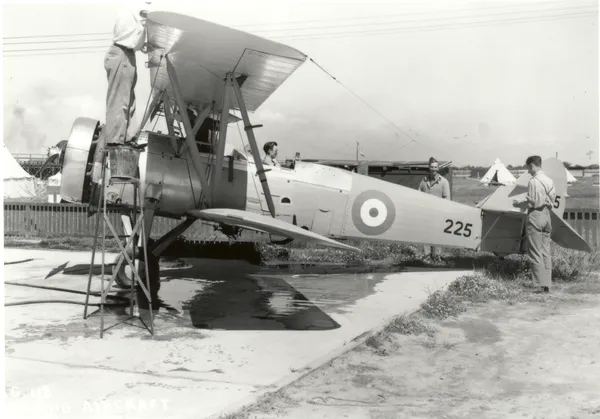Prefect (Total: 12, Canadian: 12, Group 0)
Avro Prefect

The Avro 626 is a single-engined British biplane trainer aircraft produced by Avro during the (1918-1939) inter-war period.
The Model 626 was developed by Avro from the company's Model 621 (Tutor) for export to smaller air forces, the idea being that the 626 would be a single aircraft that could carry out general aircrew training as well as a number of other roles. The types 621 and 626 were both two-seaters, but the latter had an additional cockpit behind the rear seat of the 621 and accessible from it. This additional cockpit was fitted with a Scarff ring for a machine gun and carried equipment for air navigation, wireless and gunnery training. Structurally and aerodynamically, it was almost identical to the Tutor: it had a conventional fabric-covered, metal airframe with single-bay wings. Most of the 626s, like the Tutors had an Armstrong Siddeley Lynx IVC engine of 240 hp (180 kW), but most of those supplied to the Egyptian and Brazilian Air Forces used a 260 hp (190 kW) Cheetah V from the same maker. The usual undercarriage used split, fixed mainwheels and either a tailskid or later a tailwheel, but some 621s appeared on floats and on skis
. WikipediaPrefect serial 225
s/n 225
m/d 626
c/n 927
225
Known Units:
Operated by No. 111 (AC) Squadron (Auxiliary), from RCAF Station Sea Island, BC, 1938 to 1940.last update: 2025-November-19
1940-August-15 Struck off Strength 2019-08-20
Prefect serial 226
s/n 226
m/d 626
c/n 928
226
Known Units:
Operated by No. 12 (AC) Squadron (No. 112 (AC) Sdn. (Aux.) from 15 November 1937, Winnipeg, Manitoba, 1937 to 1940. Later became Instructional Airframe A 48.last update: 2025-November-19
1940-April-25 Classified Instructional CA A 48 2020-06-13
1945-February-14 Struck off Strength 2019-08-20
Prefect serial 227
s/n 227
m/d 626
c/n 929
227
Known Units:
Fitted with partially enclosed cockpit cover. Operated by No. 110 (AC) Squadron (Auxiliary), from De Lesseps Aerodrome, Weston, Ontario, 1938 to 1939. Category B damage at Toronto on 4 October 1939. Later became Instructional Airframe A39.last update: 2025-November-19
1940-July-11 Classified Instructional A 39 2020-06-09
1940-July-12 Struck off Strength 2019-08-20
Prefect serial 266
s/n 266
m/d 626
c/n 1070
266
Known Units:
Operated by No. 112 (AC) Squadron (Aux.), Winnipeg, Manitoba, 1994 to 1940. Took part in summer exercises at Camp Shilo, Manitoba in 1939. Later became Instructional Airframe A 94.last update: 2025-November-19
1940-September-11 Classified Instructional A 94 2020-06-09
1944-February-08 Struck off Strength 2019-08-20
Prefect serial 267
s/n 267
m/d 626
c/n 1071
267
Known Units:
Operated by No. 112 (AC) Squadron (Aux.), Winnipeg, Manitoba, 1939 to 1940. AC2 T.H. Perley-Martin fell out of this aircraft on 30 August 1939, survied by using his parachute. He would be killed on 7 January 1945 as the pilot of Anson 7013 . Later became Instructional Airframe A 95.last update: 2025-November-19
1940-September-11 Classified Instructional A 95 2020-06-09
1944-February-08 Struck off Strength 2019-08-20
Prefect serial 268
s/n 268
m/d 626
c/n 1072
268
Known Units:
Operated by No. 110 (AC) Squadron (Auxiliary), from De Lesseps Aerodrome, Weston, Ontario, 1939. Later became Instructional Airframe A 38.last update: 2025-November-19
1940-July-11 Classified Instructional A 38 2020-06-09
1944-February-08 Struck off Strength 2019-08-20
Prefect serial 269
s/n 269
m/d 626
c/n 1073
269
Known Units:
Operated by No. 110 (AC) Squadron (Auxiliary), from De Lesseps Aerodrome, Weston, Ontario, 1939. Later became Instructional Airframe A 34.last update: 2025-November-19
1940-July-11 Classified Instructional A 34 2020-06-09
1945-February-14 Struck off Strength 2019-08-20
Prefect serial 270
s/n 270
m/d 626
c/n 1074
270
Known Units:
Flown by Test & Development Flight at Uplands in October 1939, to investigate reports of propeller vibration. In use at Ottawa in 1942.last update: 2025-November-19
1944-August-10 Struck off Strength 2019-08-20
Prefect serial 271
s/n 271
m/d 626
c/n 1075
271
Known Units:
Passed to No. 49 Squadron, Royal Canadian Air Cadets, as training aid.last update: 2025-November-19
1944-September-06 Struck off Strength 2019-08-20
Prefect serial 272
s/n 272
m/d 626
c/n 1076
272
Known Units:
Passed to No. 64 Squadron, Royal Canadian Air Cadets, as training aid.last update: 2025-November-19
1942-December-01 Struck off Strength 2019-08-20
Prefect serial 273
s/n 273
m/d 626
c/n 1077
273
Known Units:
With the Test and Devlopment Flight at RCAF Station Rockcliffe, Ontario. Passed to No. 2 Squadron, Royal Canadian Air Cadets, as training aid.last update: 2025-November-19
1942-June-01 Struck off Strength 2020-09-21
Prefect serial 274
s/n 274
m/d 626
c/n 1078
274
Known Units:
Passed to No. 67 Squadron, Royal Canadian Air Cadets, as training aid. Had 1 hour flight time logged when struck off.last update: 2025-November-19
1946-May-16 Struck off Strength 2019-08-20
